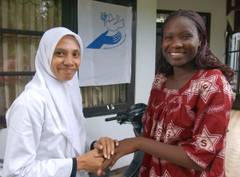Women and youth break the cycle of violence in Indonesia

Onya Ely of the Maluku Interfaith Institution greets Beatrice Mukhtar-Mamuzi, Living Letters team member from Sudan.
Photo: Peter Williams/WCC
Click here for high resolution
By Maurice Malanes (*)
The remains of flattened buildings at the Christian University of the Moluccas in Indonesia are a grim reminder of conflict. During 1999-2004 hundreds of Christians and Muslims died and millions of dollars worth of property was destroyed in a tragedy which more sober leaders and members of both faith communities regret.
"The conflict only made all of us losers," says Rev. Dr Margaretha Hendriks-Ririmasse, one of the chairpersons of the Communion of Churches in Indonesia (PGI), who hails from the Moluccas city of Ambon. "Now we have to rebuild the Christian University because 90 percent of all buildings were burned down during the conflict."
Hendriks-Ririmasse, vice-moderator of the World Council of Churches central committee, couldn't believe that such conflict erupted from a simple triggering incident - an altercation between a Christian bus driver and two Muslim passengers at a bus terminal in Ambon in January 1999.
Hendriks-Ririmasse was among local church leaders recently welcoming members of an ecumenical team called "Living Letters", who visited Ambon 18-19 July to learn more about the conflict and steps taken within the community to heal differences and end the strife.
Living Letters teams are sent by the World Council of Churches to visit locations around the world where the churches have been involved in conflict situations and working toward non-violence and reconciliation. The visits are taking place in advance of the International Ecumenical Peace Convocation to be held in Jamaica in May 2011.
Within hours of the bus terminal incident in 1999 the fighting spread throughout Ambon and then to the nearby islands of Haruku, Saparua, Seram, and Manipa, as well as the northern Moluccas.
The International Crisis Group (ICG) reports that the violence was connected to intricate local rivalries and reflected a struggle by local elites over control of the newly established province of North Maluku.
A massacre of at least 500 members of the Muslim minority in the Tobelo district of Halmahera island in December 1999 provoked calls by Muslims for a jihad in defense of the Muslims of the Moluccas, prompting the arrival of Laskar Jihad fighters five months later.
Citing independent observers, the IGC says Christian militias, supported by sympathizers in the police, had the upper hand in the early stages of the fighting. But fighters of the militant Laskar Jihad arrived in May 2000 and turned the tide.
The city of Ambon, formerly the economic hub of the Moluccas, was effectively partitioned, with indigenous Ambonese Christians occupying one end of the town and Muslims the other. Indonesian troops guarded checkpoints on the line of partition, but were unable to control the militias. Legal institutions, such as prosecutors and courts, effectively ceased to function, says the IGC.
In the areas under its control, the Laskar Jihad implemented its version of Islamic law. In March 2001 in Ambon, Laskar Jihad leader Ja'far Umar Thalib presided over the stoning to death of a man accused of adultery. Ja'far was briefly arrested for his role in the execution, but was released after protests by some sectors of the Muslim community.
In 2000 the Indonesian government deployed some 10,000 military and police personnel in Ambon but they initially failed to contain the conflict because they were also "contaminated by sectarian or local sympathies," says the IGC.
The government then deployed a mixed force of army, marine, air force, and special force, rotating them to prevent the possibility of developing inappropriate links with local combatants.
The conflict ebbed after the government in June 2002 established a "Security Restoration Operations Command" in Maluku under General Djoko Santoso. His mission: to unify efforts by the security and military forces in the province to put an end to the conflict.
Women and youth as peace-makers
While the government was responding to the conflict with armed might and mediation talks, grassroots Christian and Muslim women in Ambon were collaborating to help restore what Hendriks-Ririmasse called a long tradition of mutual help and cooperation between the two faith communities.
"We (Muslims and Christians) actually had a long tradition of being each other's keeper," said Hendriks-Ririmasse in an interview.
Until the conflict erupted in 1999, two or three villages - whether Muslim or Christian - would bind together under a pact in which all villagers regarded themselves as blood brothers or blood sisters.
Tying in with this tradition, Hendriks-Ririmasse and other Christian and Muslim women sought to restore peace in Ambon. In August 1999, they established the Caring Women's Movement, which, she says, seeks to prevent violence starting from the marketplace and grassroots communities through education and understanding each other's beliefs.
"By understanding better our Christian and Muslim faiths, we can outgrow and overcome undercurrents of prejudice, which often trigger conflict," said Hendriks-Ririmasse.
With the success of the Caring Women's Movement in grassroots peace-education, Joy Balazo, a Filipino peace advocate linked with the Uniting Church in Australia, contacted the women's group leaders and together they established in 2004 a Young Ambassadors for Peace Centre in Ambon.
The Young Ambassadors for Peace, composed of Christian and Muslim youths aged 15-19, would first undergo peace-building workshops during which they would live together for at least a week to build or renew trust among themselves.
Towards the end of each workshop, young participants draw up plans for community development projects related to agriculture and home-based industries such as sewing, carpentry and other income-generating activities in which the youth can work together as productive members of the community.
Many of the leaders of the Young Ambassadors for Peace were once recruited as combatants during the conflict. "These young people give us reason to hope for lasting peace not only in Ambon but even in neighboring provinces and regions," Hendriks-Ririmasse told the Living Letters team.
(*) Maurice Malanes is a freelance journalist from the Philippines. Currently a correspondent for Ecumenical News International (ENI), he also writes for the Manila-based Philippine Daily Inquirer, and the Bangkok-based Union of Catholic Asian News (UCAN).
More information on the Living Letters visit to Indonesia
WCC member churches in Indonesia



